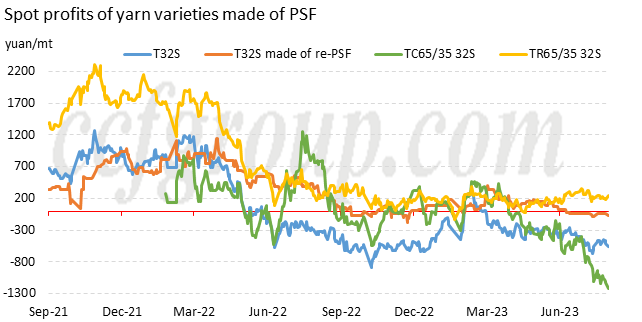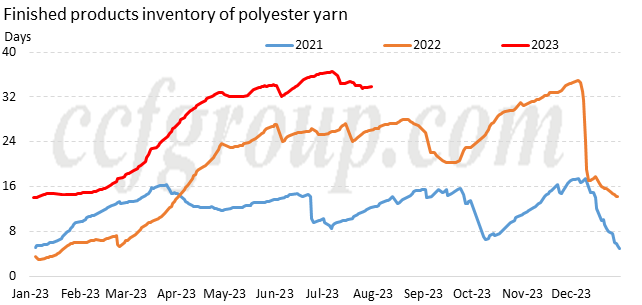Where has the PSF stock gone amidst the weak polyester yarn market?
Entering 2023, most yarn varieties made of PSF are facing difficulties, with high inventory levels and losses burdening all yarn mills.

The chart above shows the profit trends of polyester yarn varieties: pure polyester yarn has been in long-term losses in 2023, and polyester yarn made of regenerated PSF is hovering on the edge of losses. Polyester/cotton yarn could break even before May, but with the sharp rise in cotton prices at the end of May, it is walking further along the path of losses. Polyester/rayon yarn has basically not incurred losses, but the profits are only marginal.

The inventory levels of the yarn varieties vary, with pure polyester yarn having the highest inventory, remaining at high at over a month since April. Among them, ring-spun yarn has much higher inventory than vortex-spun yarn. That of blended yarn has not reached historical highs, but it is not low either.
With yarn mills facing such difficulties, one would expect the days for PSF to be equally challenging. However, PSF plants are not operating at a low rate, but stocks are not large. What is puzzling is where has the polyester short fiber stock gone?
![Y0WL]@367S@D(T9)8SHFU73.png Y0WL]@367S@D(T9)8SHFU73.png](https://pic.ccf.com.cn/2023/08/20230802040527720.png)
Firstly, the downstream yarn market is undoubtedly weak, but the production cuts are still insufficient as they are mainly concentrated on ring-spun polyester yarn, which has suffered the highest losses. Vortex-spun polyester yarn still maintains high profits, so its operating rate remains high. Comprehensive operating rate of pure polyester yarn is 55% at present, down 10 percentage points from its peak after the Spring Festival. The production reduction in blended yarn made of PSF is also insufficient. Blended yarn accounts for more than half of the consumption of solid virgin PSF and plays a crucial role in supporting PSF prices. It is important to note that although the capacity increase for ring-spun polyester yarn is relatively small, the rapid expansion of vortex-spun yarn in recent years has been a key contributor to the increase in polyester yarn capacity.
Secondly, traders hold a relatively high inventory. With the listing of PSF futures for nearly three years, an increasing number of yarn mills have started to purchase feedstock through spot pricing, resulting in the participation of more spot and future traders in market transactions, serving as reservoirs for the circulation of polyester short fibers. With the full operating of the 1.2 million ton units of Xinfengming and the start of the newly-added 300kt unit of Yida, the inventory reservoir of PSF has reached an unprecedented scale. Spot and futures traders tend to buy when prices rise and sell when they fall. The sustained upward trend in July undoubtedly had an impact on PSF sales, resulting in high stocks held by traders.
Thirdly, there has been a significant increase in PSF exports. In the first half of the year, the cumulative export of PSF reached 606kt, an increase of 118kt, or 24.2%, compared to the same period last year. This will provide a significant boost to the supply of and demand for PSF. However, over the same period, polyester yarn exports have declined significantly, asserting even greater pressure on yarn mills.
It is also important to note the adjustment in the product structure of polyester yarn. Following the sharp increase in cotton prices in May, there has been a shift in yarn products towards chemical fibers. The proportion of cotton in blended yarn has been on the decline, while the proportion of polyester has been on the rise. This adjustment is not significant at the moment, but it is important to have an eye on the longer term trend.
These various factors support the high operating rate of PSF and the still acceptable "processing fees". However, this is under the assumption of relatively stable feedstock prices. Since July, there have been successive increases in PSF price, indicating a potential disruption of the delicate balance between the upstream and downstream sectors. Careful attention needs to be paid to the future development of the industry.
- Top keywords
- Cotton Price
- Cotton Futures Price
- Cotton Futures
- CZCE
- PTA Futures Price
- Chemical Fiber
- Polyester Prices
- Wool price
- PTA Futures
- Shengze Silk
- China
- Yarn Price
- price
- China Textile City
- Fibre Price
- Benzene Price
- Cotton
- Index
- Cotton Index
- PTA
- fabric price
- NYMEX
- Top 10
- textile industry
- Spot Cotton
- Cotton Yarn
- Polyester Price
- Futures
- PTA Price
- cotton yarn price

